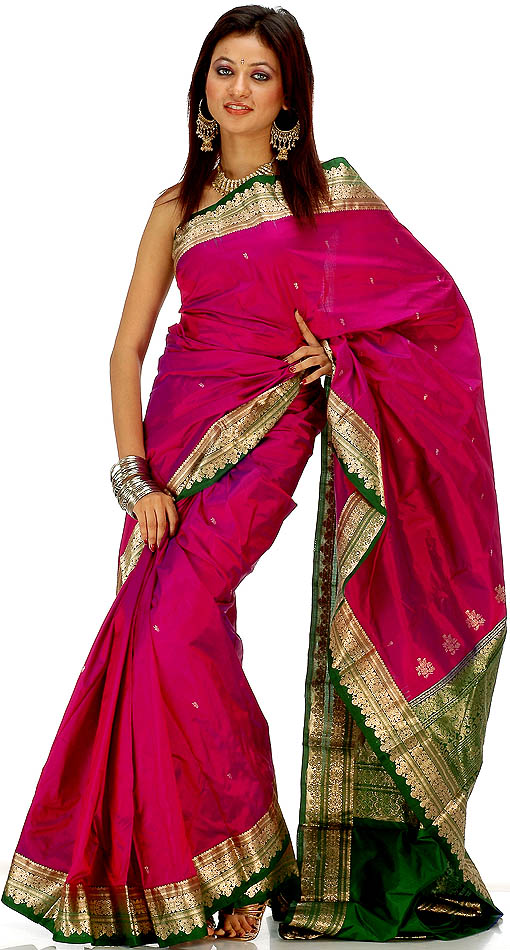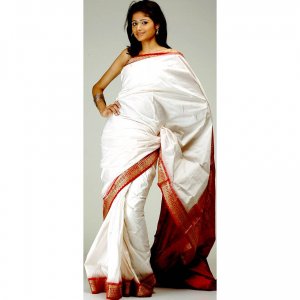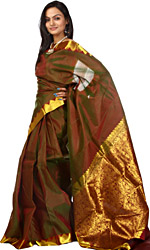Kanjivaram Sarees Biography
Source (google.com.pk)










Source (google.com.pk)
Suns, moons, chariots, peacocks, parrots, swans, lions, coins, mangoes, leaves and many such motifs are woven into Kanchipuram patterns. Other common motifs include a jasmine bud within a square or a round frame, locally known as mallinaggu. Another is Thandavalam where parallel lines run across the body of the Sari. According to legends in [Hindu mythology] Kanchi silk weavers are the descendants of Sage Markanda, the master weaver of Gods who is supposed to have woven tissue from lotus fibre. Also, while cotton is considered to the be the favourite fabric of Lord Siva while silk was preferred by Lord Vishnu. To weave a Kanchi puram sari three shuttles are used. While the weaver works on the right side, his aide works on the left side shuttle. The border color and design are usually quite different from the body. If the pallu (the hanging end of the sari) has to be woven in a different shade, it is first separately woven and then delicately joined to the Sari.The part where the body meets the pallu is often denoted by a zig zag line. Kanchipuram saris woven with heavy silk and gold cloth are considered to be special and are worn on occasions and festivities only.India, Pakistan and Bangladesh share a long history, an emerging cordial and a common vision for the future. This book is not India-centric but deals with various aspects of all the three sovereign nations. Reading them together will be an unprecedented experience rarely attempted before. It has rarely happened in the modern world, how these three nations who geographically one but culturally so different are chalking out an independent place in the comity of nations at times with the help of each other and at another on its own merit and inherent strength. It is not written from any biased perspective. In fact, it explains people, places and events from a neutral world view. It is ideally an international venture that would benefit historians, teachers and students in the entire sub-continent It will be interesting to compare the three countries from different parameters, thus planning a wholesome picture. The encyclopedia aims at clearing confusions and contradiction that have crept in because of certain vested interests and it should be read from a neutral benchmark. These volumes very clearly and earlier suggest, how fatal the disintegrate have proven to these nations with the fact that divided these countries have in actuality fallen. In the face of achieving the target of universal supremacy. India, Pakistan and Bangladesh share a long history, an emerging cordial and a common vision for the future. This book is not India-centric but deals with various aspects of all the three sovereign nations. Reading them together will be an unprecedented experience rarely attempted before. It has rarely happened in the modern world, how these three nations who geographically one but culturally so different are chalking out an independent place in the comity of nations at times with the help of each other and at another on its own merit and inherent strength. It is not written from any biased perspective. In fact, it explains people, places and events from a neutral world view. It is ideally an international venture that would benefit historians, teachers and students in the entire sub-continent It will be interesting to compare the three countries from different parameters, thus planning a wholesome picture. The encyclopedia aims at clearing confusions and contradiction that have crept in because of certain vested interests and it should be read from a neutral benchmark. These volumes very clearly and earlier suggest, how fatal the disintegrate have proven to these nations with the fact that divided these countries have in actuality fallen. In the face of achieving the target of universal supremacy.A sari or saree is a strip of unstitched cloth, worn by women, ranging from four to nine yards in length that is draped over the body in various styles which is native to the Indian Subcontinent.] The word sari is derived from Sanskrit which means 'strip of cloth'[6] and śāḍī or sāḍī in Prakrit, and which was corrupted to sāṛī in Hindi.[ The word 'Sattika' is mentioned as describing women's attire in ancient India in Buddhist Jain literature called Jatakas. This could be equivalent to modern day 'Sari'. The term for female bodice, the choli is derived from another ruling clan from south, the Cholas. Rajatarangini (meaning the 'river of kings'), a tenth century literary work by Kalhana, states that the Choli from the Deccan was introduced under the royal order in Kashmir. The concept of Pallava, the end piece in the sari, originated during the Pallavas period and named after the Pallavas, another ruling clan of Ancient Tamilakam. It is popular in India, Bangladesh, Pakistan, Nepal, Sri Lanka, Bhutan, Burma, Malaysia, and Singapore. The most common style is for the sari to be wrapped around the waist, with one end then draped over the shoulder, baring the midrif.
Kanjivaram Sarees Photos Images Pictures 2013

Kanjivaram Sarees Photos Images Pictures 2013

Kanjivaram Sarees Photos Images Pictures 2013

Kanjivaram Sarees Photos Images Pictures 2013

Kanjivaram Sarees Photos Images Pictures 2013

Kanjivaram Sarees Photos Images Pictures 2013

Kanjivaram Sarees Photos Images Pictures 2013

Kanjivaram Sarees Photos Images Pictures 2013

Kanjivaram Sarees Photos Images Pictures 2013

Kanjivaram Sarees Photos Images Pictures 2013

Kanjivaram Sarees Photos Images Pictures 2013
No comments:
Post a Comment